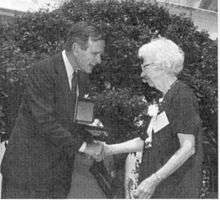Eleanor J. Gibson
| Eleanor Jack Gibson | |
|---|---|
.jpg) Eleanor Gibson - Keynote Address - 1993 APS Convention | |
| Born |
December 7, 1910 Peoria, Illinois |
| Died |
December 30, 2002 (aged 92) Columbia, South Carolina |
| Fields | psychology |
| Institutions | Cornell University |
| Alma mater |
Smith College (B.A., 1931) (M.S., 1933) Yale University (Ph.D., 1938) |
| Doctoral advisor | Clark Hull |
| Known for | Visual Cliff, Differentiation and Enrichment of Embedded Structures |
| Influences | James J. Gibson |
| Notable awards | National Medal of Science (1992) |
Eleanor Jack Gibson (December 7, 1910 – December 30, 2002) was an American psychologist. Among her contributions to psychology, the most important are the study of perception in infants and toddlers. She is popularly known for the "visual cliff" experiment in which precocial animals, and crawling human infants, showed their ability to perceive depth by avoiding the deep side of a virtual cliff.[1][2]
Along with her husband James J. Gibson, she forwarded the concept that perceptual learning takes place by differentiation. Gibson is credited with creating the Gibsonian or ecological theory of development, which centers on the concept of affordances and how children learn to perceive them.[2][3]
According to Life magazine in 1959, the "Visual Cliff" was "a wooden table from the edge of which strong plate glass extended...Children were put on the table top and coaxed to crawl out over the glass. But when they got to the edge of the cliff and looked down almost all of them quickly withdrew. Even their mothers' most persuasive urgings could not get them out." Similar studies were done with animals, including rats and kittens.[4][5]
The visual cliff findings indicated that perception is an essentially adaptive process, or as Dr. Gibson put it, We perceive to learn, as well as learn to perceive.[4]
In 1982, she was invited to Beijing to teach Chinese psychologists about recent theories and techniques of research.[4]
She was elected a Fellow of the American Academy of Arts and Sciences in 1977.[6] In 1992, Eleanor Gibson was awarded the National Medal of Science.[7] A Review of General Psychology survey, published in 2002, ranked Gibson as the 74th most cited psychologist of the 20th century, in a tie with Paul E. Meehl.[8]
References
- ↑ Rodkey, Elissa N. (2011). American Psychological Foundation "Gibson, Eleanor Jack" Check
|url= - 1 2 Pick, Anne D. (2008). "Gibson, Eleanor Jack". Dictionary of Scientific Biography 21. New York: Charles Scribner's Sons. pp. 120–125. ISBN 978-0-684-10114-9. (subscription required)
- ↑ Gibson, Eleanor J.; Pick, Anne D. (2000). An ecological approach to perceptual learning and development. New York: Oxford University Press. ISBN 0195118251.
- 1 2 3 Baranauckas, Carla (January 4, 2003). "Eleanor Gibson, 92, a Pioneer in Perception Studies, Is Dead". New York Times. Retrieved 29 October 2013.
- ↑ Gibson, E. J.; Walk, R. D. (1960). "The visual cliff". Scientific American 202: 64–72. doi:10.1038/scientificamerican0460-64.
- ↑ "Book of Members, 1780–2010: Chapter J" (PDF). American Academy of Arts and Sciences. Retrieved July 25, 2014.
- ↑ "The President's National Medal of Science: Recipient Details: Eleanor J. Gibson". National Science Foundation. Retrieved 29 October 2013.
 E. J. Gibson receiving the 1992 National Medal of Science from President Bush.
E. J. Gibson receiving the 1992 National Medal of Science from President Bush. - ↑ Haggbloom, Steven J.; Warnick, Jason E.; Jones, Vinessa K.; Yarbrough, Gary L.; Russell, Tenea M.; Borecky, Chris M.; McGahhey, Reagan; et al. (2002). "The 100 most eminent psychologists of the 20th century". Review of General Psychology 6 (2): 139–152. doi:10.1037/1089-2680.6.2.139.
Further reading
- Wayne, Tiffany K. (2010). "Gibson, Eleanor Jack". American women of science since 1900. Santa Barbara, Calif.: ABC-CLIO. pp. 429–430. ISBN 9781598841589.
External links
- "Gibson, Eleanor J." in Encyclopedia.com by Patricia Skinner
- Transcript of oral history interview and CV (both in PDF format) from the Society for Research in Child Development
- Eleanor J. Gibson profile at Psychology's Feminist Voices
- Eleanor Gibson Profile on Psychology's Feminist Voices
|